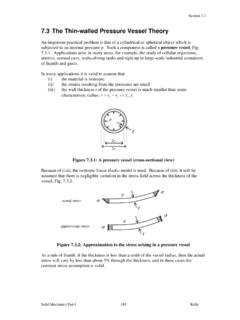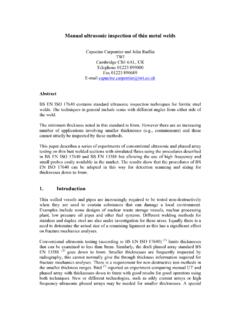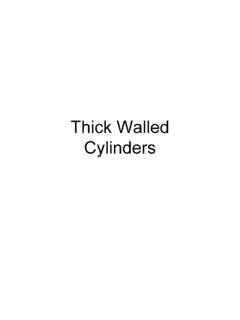Transcription of MECHANICAL PRINCIPLES THIN WALLED VESSELS and …
1 MECHANICAL PRINCIPLES thin WALLED VESSELS and thick WALLED CYLINDERS You should judge your progress by completing the self assessment exercises. When you have completed this tutorial you should be able to do the following. Define a thin WALLED cylinder. Solve circumferential and longitudinal stresses in thin WALLED cylinders. Solve circumferential and longitudinal stresses in thin WALLED spheres. Calculate the bursting pressure of thin WALLED cylinders and spheres. Define a thick WALLED cylinder. Solve circumferential, radial and longitudinal stresses in thick WALLED cylinders. Calculate changes in diameter and volume due to pressure . Solve problems involving the compression of fluids into pressure VESSELS .
2 Solve problems involving interference fits between shafts and sleeves. INDEX 1. thin WALLED Cylinders 2. thin WALLED Spheres 3. Volume Changes 4. thick Cylinders 5. Interference Between Shafts and Sleeves 2 1. thin WALLED CYLINDER. A cylinder is regarded as thin WALLED when the wall thickness t is less than 1/20 of the diameter D. When the wall is thicker than this, it is regarded as a thick wall and it is treated differently as described later. Consider a cylinder of mean diameter D, wall thickness t and length L. When the pressure inside is larger than the pressure outside by p, the cylinder will tend to split along a length and along a circumference as shown in figures 1 and 2.
3 Figure 1 Figure 2 The stress produced in the longitudinal direction is Land in the circumferential direction is c. These are called the longitudinal and circumferential stresses respectively. The latter is also called the hoop stress. Consider the forces trying to split the cylinder about a circumference ( ). So long as the wall thickness is small compared to the diameter then the force trying to split it due to the pressure is 42 DppAF ..( ) So long as the material holds then the force is balanced by the stress in the wall. The force due to the stress is DtFLL metal theof area by the multiplied ..( ) 3 Equating and we have tpDL4 ..( ) Now consider the forces trying to split the cylinder along a length.
4 The force due to the pressure is pLDpAF ..( ) So long as the material holds this is balanced by the stress in the material. The force due to the stress is LtFCC2 metal theof area y the multiplied ..( ) Equating and we have tpDC2 ..( ) It follows that for a given pressure the circumferential stress is twice the longitudinal stress. WORKED EXAMPLE A cylinder is 300 mm mean diameter with a wall 2 mm thick . Calculate the maximum pressure difference allowed between the inside and outside if the stress in the wall must not exceed 150 MPa. SOLUTION The solution must be based on the circumferential stress since this is the largest. c = pD/2t = 150 MPa p = 150 MPa x 2t/D = 150 x 2 x p = 2 MPa 4 2.
5 thin WALLED SPHERE A sphere will tend to split about a diameter as shown in Figure 3 The stress produced in the material is equivalent to the longitudinal stress in the cylinder so tpDC4 ..( ) WORKED EXAMPLE Calculate the maximum allowable pressure difference between the inside and outside of a sphere 50 mm mean diameter with a wall mm thick if the maximum allowable stress is MPa. SOLUTION Using equation G we have = pD/4t = 150 MPa p = x 4t/D = x 4 x = 72 kPa SELF ASSESSMENT EXERCISE 1. A thin WALLED cylinder is 80 mm mean diameter with a wall 1 mm thick . Calculate the longitudinal and circumferential stresses when the inside pressure is 500 kPa larger than on the outside. (Answers 10 MPa and 20 MPa).
6 2. Calculate the wall thickness required for a thin WALLED cylinder which must withstand a pressure difference of MPa between the inside and outside. The mean diameter is 200 mm and the stress must not exceed 60 MPa. (Answer mm) 3. Calculate the stress in a thin WALLED sphere 100 mm mean diameter with a wall 2 mm thick when the outside pressure is 2 MPa greater than the inside. (Answer -25 MPa). 5 3. VOLUME CHANGES We will now look at how we calculate the changes in volume of thin WALLED VESSELS when they are pressurised. CYLINDERS Consider a small rectangular area which is part of the wall in a thin WALLED cylinder (figure 4). Figure 4 There are two direct stresses perpendicular to each other, c and L.
7 From basic stress and strain theory (tutorial 1), the corresponding longitudinal strain is : CLLE 1 E is the modulus of elasticity and is Poisson's ratio. Substituting L= pD/4t and c=pD/2t we have ) (..214241 tEpDtpDtpDELLL The circumferential strain may be defined as follows. c= change in circumference/original circumference DDDDDDC The circumferential strain is the same as the strain based on diameter, in other words the diametric strain. From basic stress and strain theory, the corresponding circumferential strain is : LCCE 1 Substituting L= pD/4t and c=pD/2t we have ) (..24421 tEpDtpDtpDEDDDC Now we may deduce the change in diameter, length and volume. Original cross sectional area of cylinder = A1 = D2/4 Original length = L1 Original volume =V1 = A1 L1=( D2/4)(L1) New cross sectional area = A2 = ( D + D)2 New length = L2 = L + L New volume = V2 = A2L2= {( D + D)2}(L1 + L) Change in volume = V = V2 -V1 Volumetric strain = v = V/V1 6 121212121212444444 LDLDLLDDL DL DLLDD V Dividing out and clearing brackets and ignoring the product of two small terms, this reduces to ) (.
8 221 DLVDDLL If we substitute equation and into this we find ) (..454 tEpDV WORKED EXAMPLE A cylinder is 150 mm mean diameter and 750 mm long with a wall 2 mm thick . It has an internal pressure MPa greater than the outside pressure . Calculate the following. i. The circumferential strain. ii. The longitudinal strain. iii. The change in cross sectional area. iv. The change in length. iv. The change in volume. Take E = 200 GPa and = SOLUTION c= pD/2t = 30 MPa L= pD/4t = 15 MPa D= D/D = (pD/4tE)(2 - ) = D = 150 x x 10-6 = mm D2 = mm A1 = x 1502/4 = mm2 A2 = x = mm2 Change in area = mm2 L= L/L1 = (pD/4tE)(1 - 2 ) = L= 750 x x 10-6 = mm Original volume = A1L1 = 13 253 600 mm3 Final volume = A2L2 = 13 257 600 mm3 Change in volume = 4000 mm3 Check the last answer from equation v =(pD/4tE)(5 - 4 ) = 300 x 10-6 Change in volume = V1 x v = 13 253 600 x 300 x 10-6 = 4000 mm3 7 SPHERES Consider a small rectangular section of the wall of a thin WALLED sphere.
9 There are two stresses mutually perpendicular similar to fig. 4 but in this case the circumferential stress is the same as the longitudinal stress. The longitudinal strain is the same as the circumferential strain so equation becomes v = D + 2 D v = 3 D ..( ) The strain in any direction resulting from the two mutually perpendicular equal stresses is D= ( /E)(1- ) Hence v = 3( /E)(1- ) ..( ) WORKED EXAMPLE No. 4 A sphere is 120 mm mean diameter with a wall 1 mm thick . The pressure outside is 1 MPa more than the pressure inside. Calculate the change in volume. Take E = 205 GPa and = SOLUTION v = 3( /E)(1- ) = (note the sphere shrinks hence the negative sign) Original volume = D3/6 = 904778 mm3 Change in volume = -904778 x x 10-6 = -294 mm3 8 WORKED EXAMPLE No.
10 5 In example the internal pressure is created by pumping water into the cylinder. Allowing for the compressibility of the water, deduce the volume of water at the outside pressure required to fill and pressurise the cylinder. The bulk modulus K for water is GPa. SOLUTION Initial volume of cylinder = V1 = 13 253 600 mm3 = volume of uncompressed water Final volume of cylinder = V2 = 13 257 600 mm3 = volume of compressed water. If V2 was uncompressed it would have a larger volume V3. V3 = V2 + V (all volumes refer to water). From the relationship between pressure and volumetric strain we have V = pV3/K = x 106 x V3/ x 109 = x 10-6V3 V3 = 13 257 600 + x 10-6V3 = 13 257 600 V3 = 13 262 700 mm3 This is the volume required to fill and pressurise the cylinder.












